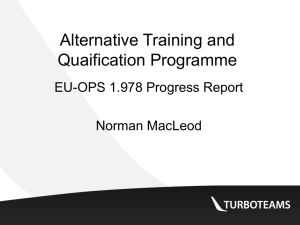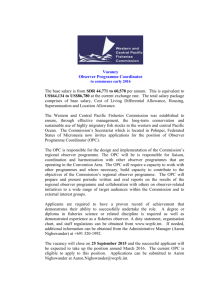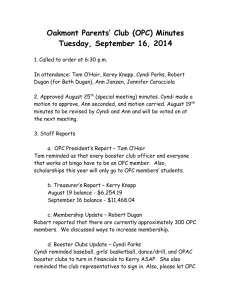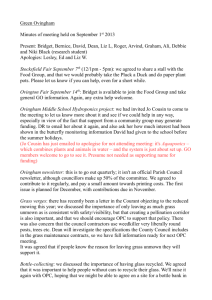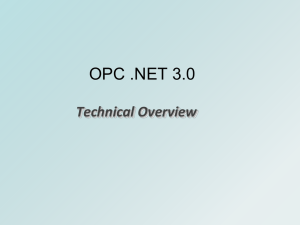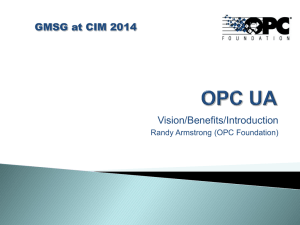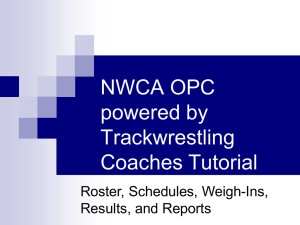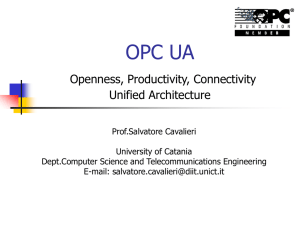OPC Quality flags Explanation Excer~
advertisement
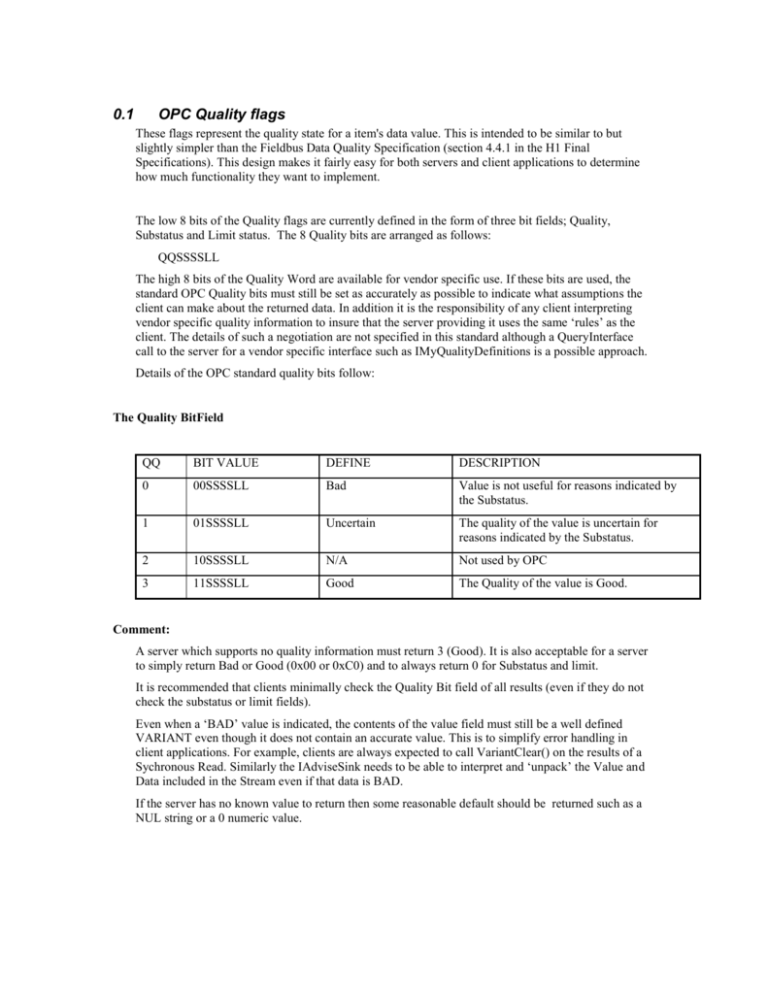
0.1 OPC Quality flags These flags represent the quality state for a item's data value. This is intended to be similar to but slightly simpler than the Fieldbus Data Quality Specification (section 4.4.1 in the H1 Final Specifications). This design makes it fairly easy for both servers and client applications to determine how much functionality they want to implement. The low 8 bits of the Quality flags are currently defined in the form of three bit fields; Quality, Substatus and Limit status. The 8 Quality bits are arranged as follows: QQSSSSLL The high 8 bits of the Quality Word are available for vendor specific use. If these bits are used, the standard OPC Quality bits must still be set as accurately as possible to indicate what assumptions the client can make about the returned data. In addition it is the responsibility of any client interpreting vendor specific quality information to insure that the server providing it uses the same ‘rules’ as the client. The details of such a negotiation are not specified in this standard although a QueryInterface call to the server for a vendor specific interface such as IMyQualityDefinitions is a possible approach. Details of the OPC standard quality bits follow: The Quality BitField QQ BIT VALUE DEFINE DESCRIPTION 0 00SSSSLL Bad Value is not useful for reasons indicated by the Substatus. 1 01SSSSLL Uncertain The quality of the value is uncertain for reasons indicated by the Substatus. 2 10SSSSLL N/A Not used by OPC 3 11SSSSLL Good The Quality of the value is Good. Comment: A server which supports no quality information must return 3 (Good). It is also acceptable for a server to simply return Bad or Good (0x00 or 0xC0) and to always return 0 for Substatus and limit. It is recommended that clients minimally check the Quality Bit field of all results (even if they do not check the substatus or limit fields). Even when a ‘BAD’ value is indicated, the contents of the value field must still be a well defined VARIANT even though it does not contain an accurate value. This is to simplify error handling in client applications. For example, clients are always expected to call VariantClear() on the results of a Sychronous Read. Similarly the IAdviseSink needs to be able to interpret and ‘unpack’ the Value and Data included in the Stream even if that data is BAD. If the server has no known value to return then some reasonable default should be returned such as a NUL string or a 0 numeric value. The Substatus BitField The layout of this field depends on the value of the Quality Field. Substatus for BAD Quality: SSSS BIT VALUE DEFINE DESCRIPTION 0 000000LL Non-specific The value is bad but no specific reason is known 1 000001LL Configuration Error There is some server specific problem with the configuration. For example the item is question has been deleted from the configuration. 2 000010LL Not Connected The input is required to be logically connected to something but is not. This quality may reflect that no value is available at this time, for reasons like the value may have not been provided by the data source. 3 000011LL Device Failure A device failure has been detected 4 000100LL Sensor Failure A sensor failure had been detected (the ’Limits’ field can provide additional diagnostic information in some situations.) 5 000101LL Last Known Value Communications have failed. However, the last known value is available. Note that the ‘age’ of the value may be determined from the TIMESTAMP in the OPCITEMSTATE. 6 000110LL Comm Failure Communications have failed. There is no last known value is available. 7 000111LL Out of Service The block is off scan or otherwise locked This quality is also used when the active state of the item or the group containing the item is InActive. N/A Not used by OPC 8-15 Comment Servers which do not support Substatus should return 0. Note that an ‘old’ value may be returned with the Quality set to BAD (0) and the Substatus set to 5. This is for consistency with the Fieldbus Specification. This is the only case in which a client may assume that a ‘BAD’ value is still usable by the application. Substatus for UNCERTAIN Quality: SSSS BIT VALUE DEFINE DESCRIPTION 0 010000LL Non-specific There is no specific reason why the value is uncertain. 1 010001LL Last Usable Value Whatever was writing this value has stopped doing so. The returned value should be regarded as ‘stale’. Note that this differs from a BAD value with Substatus 5 (Last Known Value). That status is associated specifically with a detectable communications error on a ‘fetched’ value. This error is associated with the failure of some external source to ‘put’ something into the value within an acceptable period of time. Note that the ‘age’ of the value can be determined from the TIMESTAMP in OPCITEMSTATE. N/A Not used by OPC 2-3 4 010100LL Sensor Not Accurate Either the value has ‘pegged’ at one of the sensor limits (in which case the limit field should be set to 1 or 2) or the sensor is otherwise known to be out of calibration via some form of internal diagnostics (in which case the limit field should be 0). 5 010101LL Engineering Units Exceeded The returned value is outside the limits defined for this parameter. Note that in this case (per the Fieldbus Specification) the ‘Limits’ field indicates which limit has been exceeded but does NOT necessarily imply that the value cannot move farther out of range. 6 010110LL Sub-Normal The value is derived from multiple sources and has less than the required number of Good sources. N/A Not used by OPC 7-15 Comment Servers which do not support Substatus should return 0. Substatus for GOOD Quality: SSSS BIT VALUE DEFINE DESCRIPTION 0 110000LL Non-specific The value is good. There are no special conditions N/A Not used by OPC Local Override The value has been Overridden. Typically this is means the input has been disconnected and a manually entered value has been ‘forced’. N/A Not used by OPC 1-5 6 110110LL 7-15 Comment Servers which do not support Substatus should return 0. The Limit BitField The Limit Field is valid regardless of the Quality and Substatus. In some cases such as Sensor Failure it can provide useful diagnostic information. LL BIT VALUE DEFINE DESCRIPTION 0 QQSSSS00 Not Limited The value is free to move up or down 1 QQSSSS01 Low Limited The value has ‘pegged’ at some lower limit 2 QQSSSS10 High Limited The value has ‘pegged’ at some high limit. 3 QQSSSS11 Constant The value is a constant and cannot move. Comment Servers which do not support Limit should return 0. Symbolic Equates are defined for values and masks for these BitFields in the “QUALITY” section of the OPC header files. 1 Summary of OPC Error Codes We have attempted to minimize the number of unique errors by identifying common generic problems and defining error codes that can be reused in many contexts. An OPC server should only return those OPC errors that are listed for the various methods in this specification or are standard Microsoft errors. Note that OLE itself will frequently return errors (such as RPC errors) in addition to those listed in this specification. The most important thing for a client is to check FAILED for any error return. Other than that, (the statements above not withstanding) a robust, user friendly client should assume that the server may return any error code and should call the GetErrorString function to provide user readable information about those errors. Standard COM errors that are commonly used by OPC Servers Description E_FAIL Unspecified error E_INVALIDARG The value of one or more parameters was not valid. This is generally used in place of a more specific error where it is expected that problems are unlikely or will be easy to identify (for example when there is only one parameter). E_NOINTERFACE E_NOTIMPL No such interface supported Not implemented E_OUTOFMEMORY Not enough memory to complete the requested operation. This can happen any time the server needs to allocate memory to complete the requested operation. CONNECT_E_ADVISELIMIT OLE_E_NOCONNECTION DV_E_FORMATETC Advise limit exceeded for this object Cannot Unadvise - there is no existing connection Invalid or unregistered Format specified in FORMATETC OPC Specific Errors Description OPC_E_BADRIGHTS The Items AccessRights do not allow the operation. OPC_E_BADTYPE The server cannot convert the data between the specified format/ requested data type and the canonical data type. OPC_E_DUPLICATENAME Duplicate name not allowed. OPC_E_INVALIDCONFIGFILE The server's configuration file is an invalid format. OPC_E_INVALIDFILTER The filter string was not valid OPC_E_INVALIDHANDLE The value of the handle is invalid. Note: a client should never pass an invalid handle to a server. If this error occurs, it is due to a programming error in the client or possibly in the server. OPC_E_INVALIDITEMID The item ID doesn't conform to the server's syntax. OPC_E_INVALID_PID The passed property ID is not valid for the item. OPC_E_NOTFOUND Requested Object (e.g. a public group) was not found. OPC_E_PUBLIC The requested operation cannot be done on a public group. OPC_E_RANGE The value was out of range. OPC_E_UNKNOWNITEMID The item ID is not defined in the server address space (on add or validate) or no longer exists in the server address space (for read or write). OPC_E_UNKNOWNPATH The item's access path is not known to the server. OPC_S_CLAMP A value passed to WRITE was accepted but the output was clamped. OPC_S_INUSE The operation cannot be performed because the object is bering referenced. OPC_S_UNSUPPORTEDRATE The server does not support the requested data rate but will use the closest available rate.
